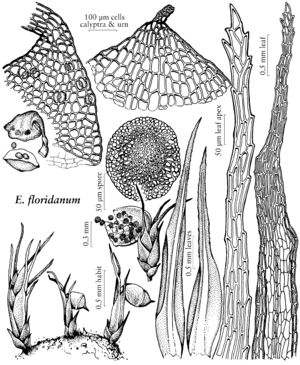Eccremidium
London J. Bot. 5: 450. 1846 ,.
| Taxon | Illustrator ⠉ | |
|---|---|---|
 | Eccremidium floridanum | Patricia M. Eckel |
Plants scattered or in loose to compact turfs, mostly yellowish green, sometimes reddish. Stems erect, to ca. 0.5 mm, sometimes seemingly absent; simple or branched by innovations; rhizoids at base, smooth. Leaves imbricate to spreading when dry, lanceolate to ovate, acute to subulate; margins plane, entire or serrate; costa subpercurrent to excurrent, sometimes weak or absent toward insertion and in lowermost leaves, medial laminal cells rhomboidal to shortrectangular, becoming longer toward the insertion, smooth. Specialized asexual reproduction unknown. Sexual condition autoicous or dioicous, cladocarpous; perichaetial leaves sometimes differentiated. Seta short, curved at apex, rarely ± erect. Capsule pendulous and laterally emergent, rarely erect and immersed, reddish at maturity, subglobose; annulus near midurn, of 1–2 rows of small cells, persistent; operculum obtuse to apiculate; peristome none. Calyptra conic-mitrate, entire at base or crenate-lobed. Spores globose to reniform, coarsely papillose to reticulate.
Distribution
North America, South America, Asia, Africa, Australia
Discussion
Species 6 (1 in the flora).